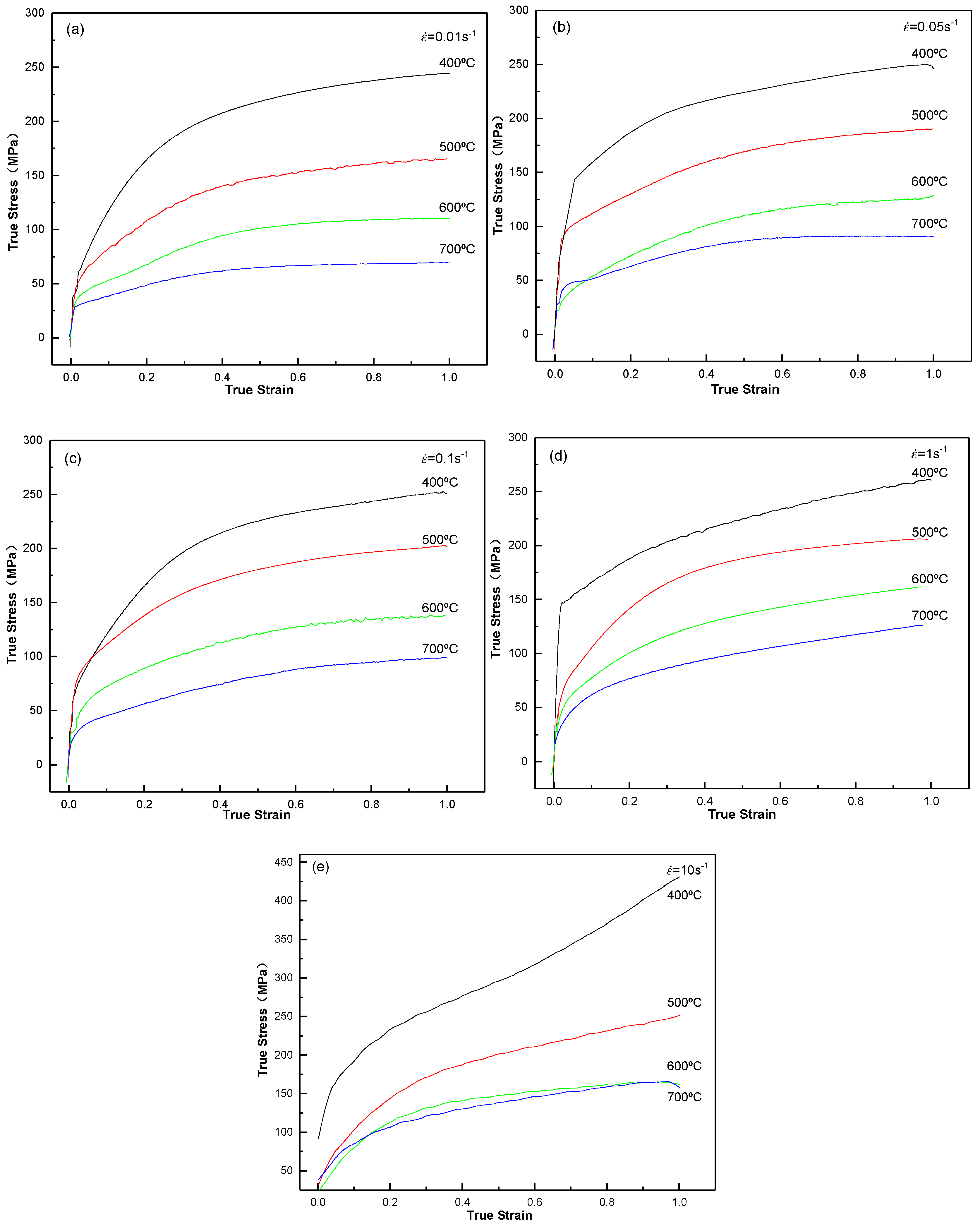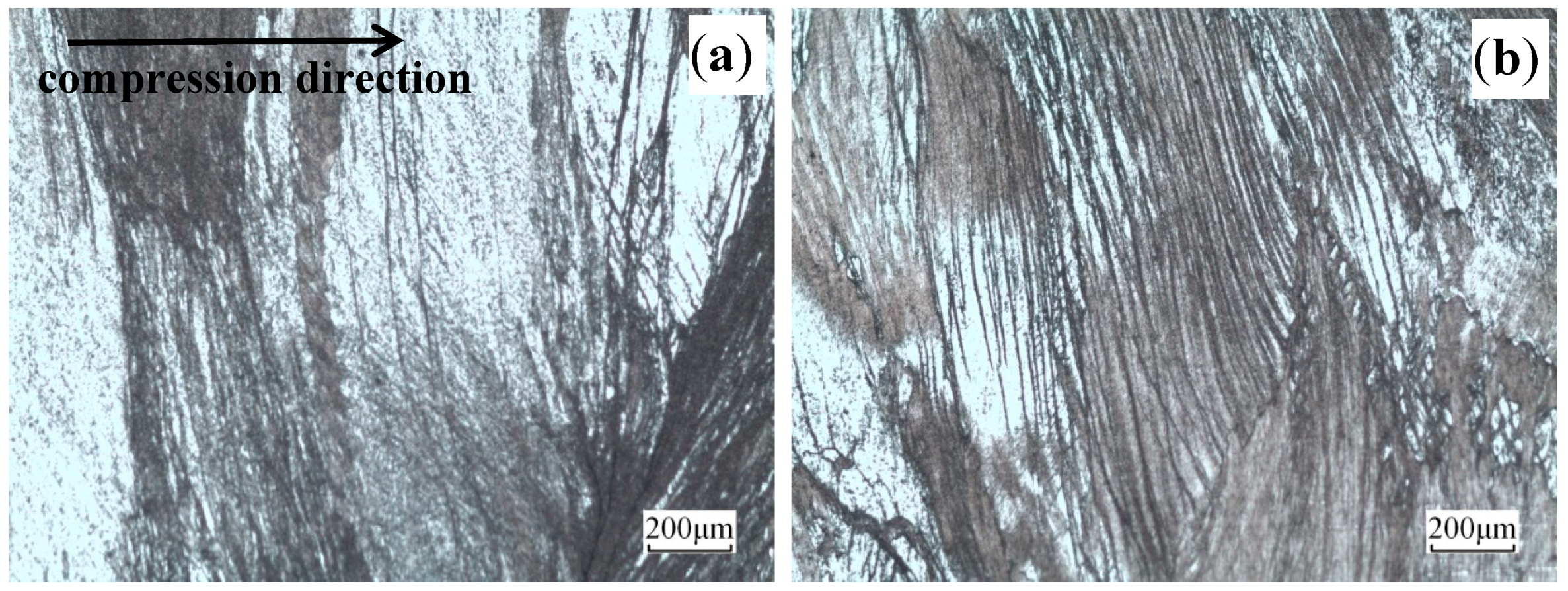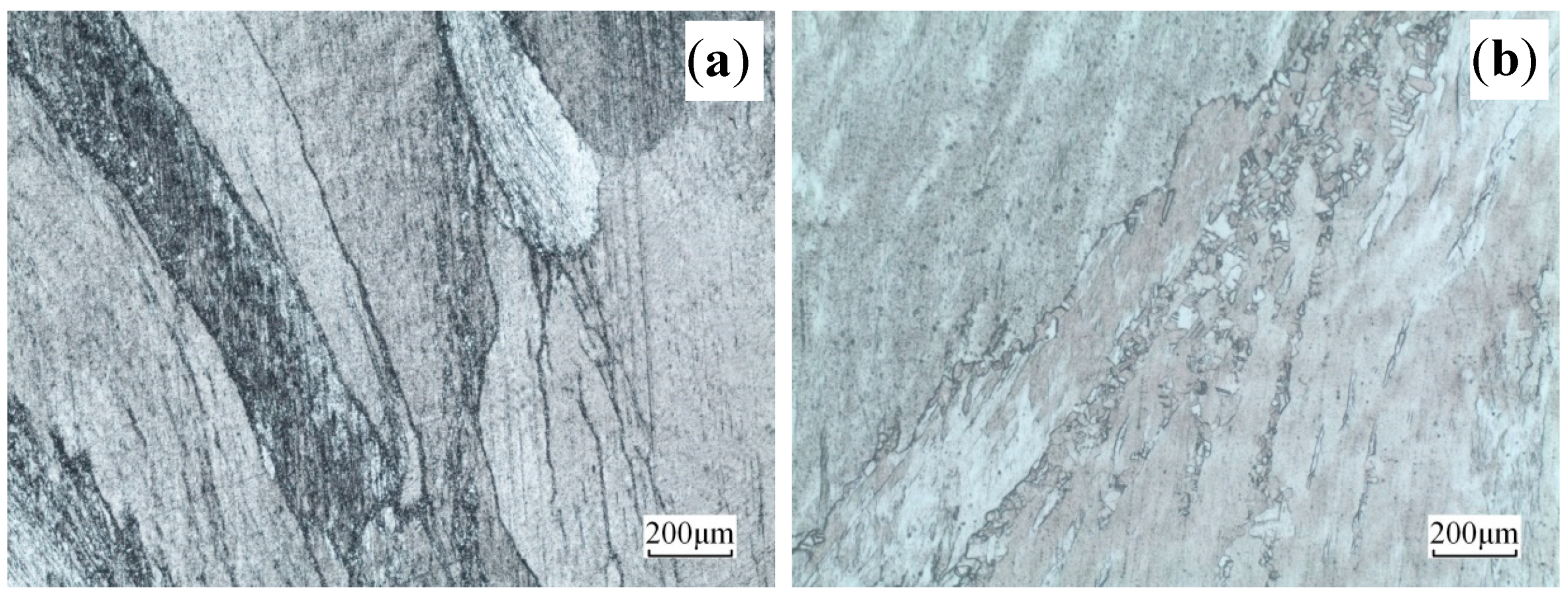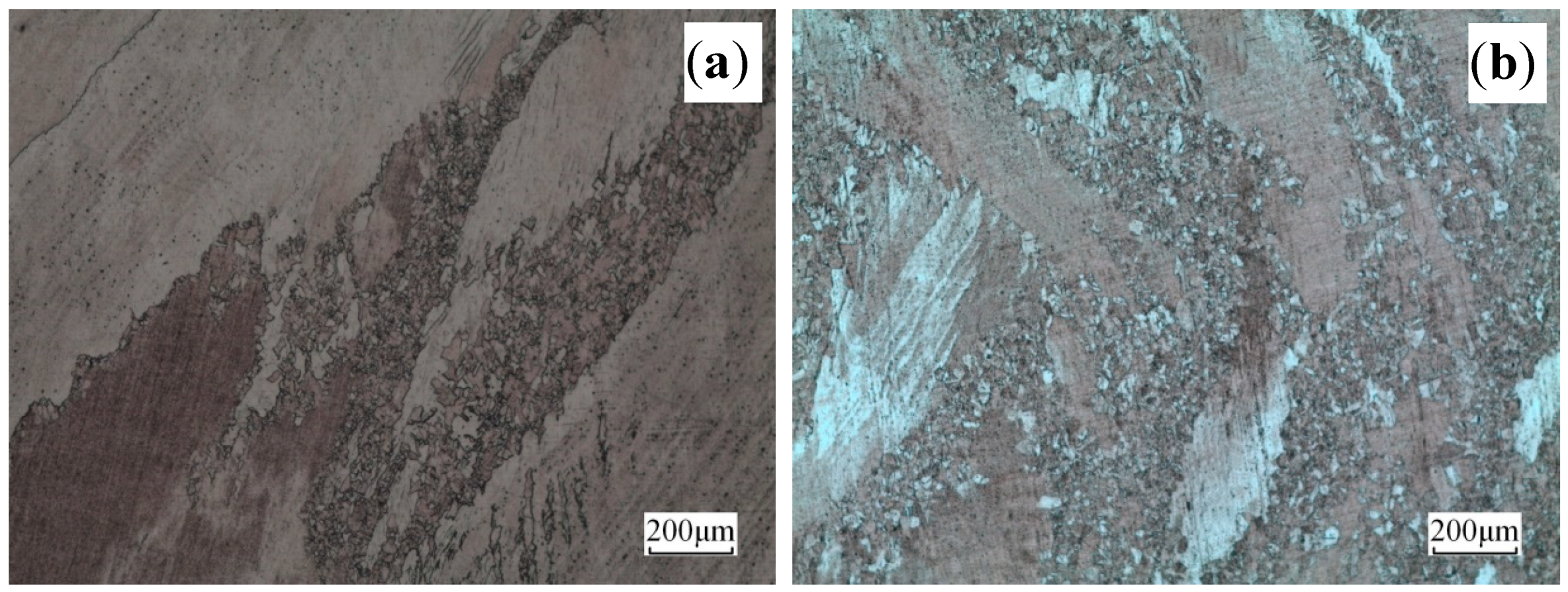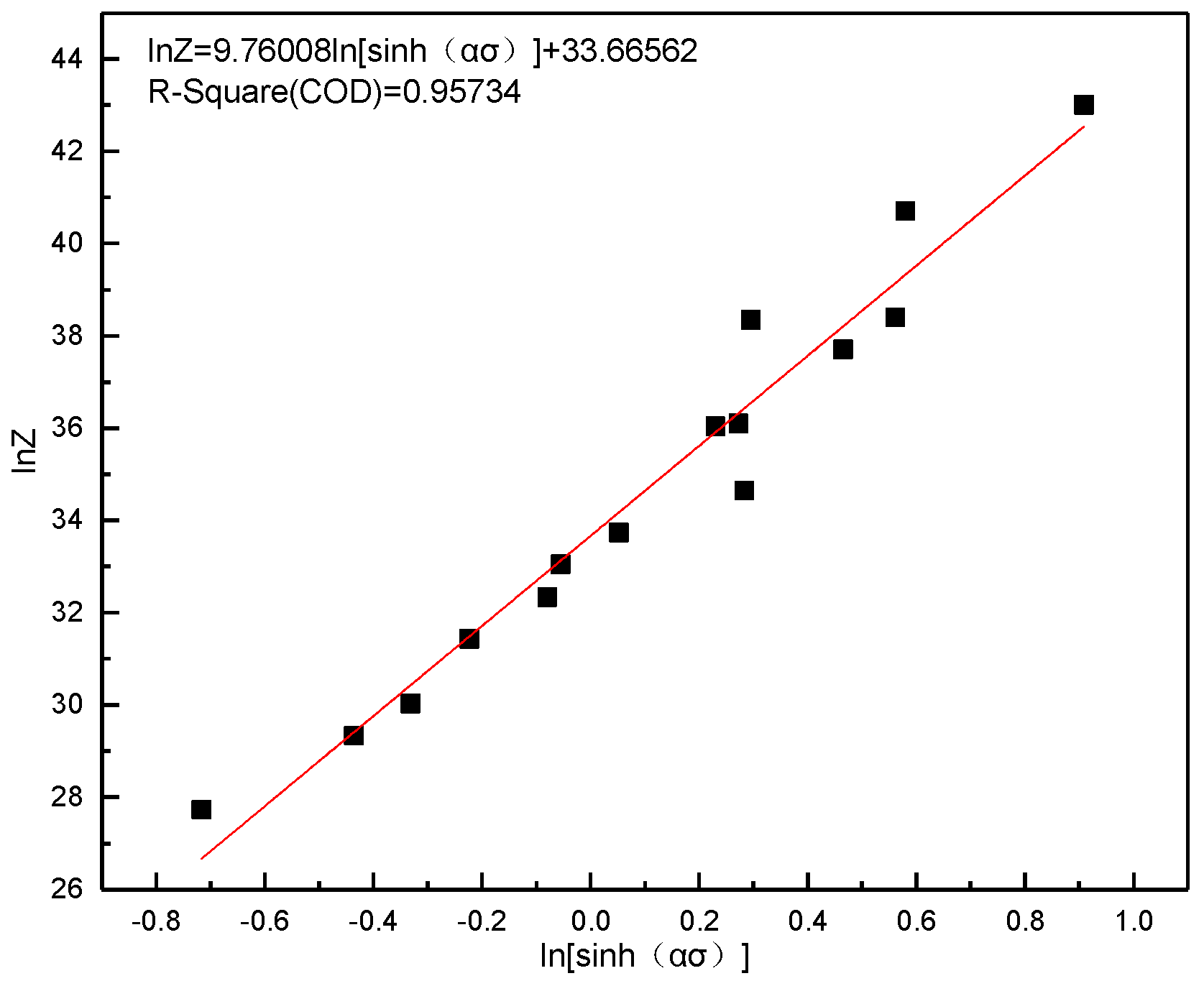3.1. Stress–Strain Behaviors
The stress–strain behaviors of the Cu–0.55Sn–0.08La alloy at various strain rates and deformation temperatures are displayed in
Figure 2. The mechanical energy of the specimen is converted into heat energy during compression; therefore, the temperature rise of the sample is large at a high strain rate, thus it is necessary to modify the experimental data of the stress–strain curve for a strain rate of 10 s
−1 with temperature [
19], and
Figure 2e exhibits the modified curve. At fixed deformation temperature, both the flow stress and peak stress increased with strain rate, indicating the positive strain rate sensitivity of the alloy; at fixed strain rate, both the flow stress and peak stress declined with temperature, suggesting the heat-sensitive nature of the alloy [
20].
The shape of the flow curves exhibited dependence on the initial grain size and steady DRX (dynamic recrystallization) grain size [
21].
Figure 3 is initial grain of uncompressed specimen and Figure 7 is the partial recrystallized grain of the compressed deformation alloy. Compared to the initial grain size (1.40 mm) of the test sample was significantly large, the recrystallized grain size (0.06 mm) after dynamic compression. As a result, no peak or only one peak appeared in the stress–strain curve.
Moreover, the shape of each flow curve strongly depended on the solution concentration [
22].
The flow stress of the copper alloy was always higher than that of the pure copper under the same temperature and strain rate. The mass fractions of Sn and La in the specimens were determined as 0.55 and 0.08%, respectively. Both the Cu–La intermetallic compounds and Sn solute elements increased the dislocation movement difficulty in the copper matrix, thereby increasing the flow stress of the copper alloy.
At the strain rates of 0.01–1 s−1 and 400 °C, the flow stress first increased rapidly with strain and then tended to increase slowly, showing typical work hardening features. At strain rates of 10 s−1, the flow stress increased faster than the low strain rate due to the obvious work hardening effect. The final stage of the curve still displayed an upward trend, indicating the dominance of the work hardening. As the strain rate increased, the peak of flow stress increased slowly from 0.01 to 1 s−1. For strain rates exceeding the critical value (1 s−1), the peak of flow stress increased significantly. When the strain rate increased rapidly, the plastic deformation occurred in a short time, the deformed grains could not recover or recrystallize in time, the work hardening effect was significant, the dislocation density in the alloy increased, and the flow stress peak value increased significantly.
At 500–600 °C, the flow stress first of all increased rapidly with strain and then tended to stabilize without obvious flow stress peaks and sharp softening trend. With the increase of strain rate from 0.01 to 0.05 s−1 at 500 °C, the peak value of flow stress increased rapidly and then tended to stabilize from 0.1 to 1 s−1. At strain rates exceeding 1 s−1, the peak value of the flow stress enhanced significantly. The peak flow stress would enhance significantly, once the strain rate exceeded 1 s−1. At 600 °C, from 0.01 to 1 s−1, the peak flow stress further increased. As the strain rate reached 1 s−1, the peak flow stress hardly increased.
At 700 °C, the flow stress increased rapidly with strain and then tended to stabilize, indicating the important role of dynamic softening in the process. As strain rate incremented, the peak value of the flow stress increased gradually. At 0.01–0.05 s−1, the flow stress tended to stabilize as the strain increased. From 0.1 to 10 s−1, the flow stress tended to increase slightly with further increase in strain.
Above all, in the range of 400–700 °C, 0.01–10 s
−1, during the compression experiment, strain hardening and dynamic recovery occurred simultaneously at lower temperature or higher strain rate. With dislocation proliferation, accretion, recombination, and annihilation, the dislocation distribution was observed first to be uneven and then gradually evolved into an independent cellular structure in different dislocation tangled areas [
21]. This led to the formation of dislocation cells and reduction in dislocation density. Consequently, the stress–strain curve increased slowly at 400 °C (
Figure 2a,b). At high deformation temperatures or low strain rates, the deformation process was accompanied by the formation and growth of recrystallized crystal nuclei, and the softening rate of the alloy appeared greater than or equal to the deformation hardening rate [
23]. Thus, the stress–strain curve tended to stabilize (
Figure 2a,b at 700 °C). At a deformation hardening rate equivalent to dynamic recovery and dynamic recrystallization rate, the stress–strain curve was stable (
Figure 2a,b at 600 °C). The reason for the above-mentioned different laws can be attributed to the competition between dynamic hardening and dynamic softening phenomena.
On the other hand, since the alloy was characterized with low stacking fault energy, its extended dislocations were very wide. Moreover, the dislocations were difficult to extricate from the dislocation network as well as challenging to offset each other through cross slip and climb. At the beginning of deformation, the recovery of the sub-structure was very slow. This led to very high dislocation density in the sub-structure, a very small structure of the sub crystal, and many dislocation tangles in the cell wall.
3.2. Microstructure
The macrostructure of an uncompressed specimen is presented in
Figure 3. The morphology was generated by different orientations of casting grains, where a single-phase microstructure was etched into different colors. At the edge of the ingot, oblique columnar crystals were formed attributed to the horizontal cooling direction and upward vertical movement. The cooling rate of the ingot center decreased and a few grains with smaller sizes appeared. The average length of the grains on the right side was estimated to be about 3 mm and width was around 0.5 mm. The average length of the grains on the left side was about 10 mm and the width was around 1 mm. Furthermore, the grains on the left and right sides showed obvious boundaries. This was caused by the different cooling rates on both sides of the ingot.
The microstructures of the deformed Cu–Sn–La alloy at 400 °C under different strain rates are illustrated in
Figure 4. Due to the large initial grain size, macro coordinated deformation is difficult. The deformation of each grain appeared to be extremely uneven. Moreover, many slip bands and adiabatic shear bands were present in some grains [
24], which were terminated at the grain boundary [
25,
26]. Under compression deformation, the grains rotated to become gradually perpendicular to the compression direction. Compared to
Figure 4a, the slip bands in the grains became denser in
Figure 4b as strain rate increased.
The microstructures of the alloy deformed at 500 °C and different strain rates are presented in
Figure 5. At low strain rate (
= 0.01 s
−1), shear bands still existed and dynamically recrystallized grains appeared in the shear bands (
Figure 5a). Thus, the dynamic recrystallization occurred locally with the formation of large numbers of fine dynamic recrystallized grains at the grain boundary. This led to of the formation of large numbers of “necklace structures”. As strain rate increased, at higher strain rate (
= 10 s
−1), numerous fine recrystallized grains and annealing twins appeared (
Figure 5b). In
Figure 5b, the wave-like grain boundaries are usually observed under DRX conditions; noteworthy,
Figure 5b exhibits that annealing twins were evolved in dynamic grains, although their density was lower than that for statically annealed grains [
22].
The microstructures of the alloy deformed at 600 °C and different strain rates are provided in
Figure 6. At low and high strain rates (
= 0.01 s
−1 and
= 10 s
−1), dynamically recrystallized grains were noted and became obvious as strain rate increased (
Figure 6b). Furthermore, the grain boundary preferentially nucleated (
Figure 6), and dynamically recrystallized grains gradually expanded and grew around by devouring the surrounding deformed matrix. The latter was due to the grain boundary, which possessed basic conditions of recrystallization nucleation of large-angle interface with high-density defects and superior deformation energy. At this place, recrystallization exhibited priority for nucleation and growth, forming fine and equiaxed recrystallization structures.
The microstructures of the alloy deformed at 700 °C at different strain rates are displayed in
Figure 7. Fine recrystallization in the center of
Figure 7b was observed, A and B were coarse original grains, and the boundary between the recrystallized grain and original grain appeared to be clear. During dynamic recrystallization, the La rich phase prevented the grain boundary from migrating, thereby reducing the size of the dynamic recrystallization grain.
On the other hand, the recrystallized grain sizes at high strain rates were larger at the same temperature since higher deformation temperatures led to higher thermal activation energy. Furthermore, more complete thermal activation processes led to less storage energy after deformation, thus delaying recrystallization and forming smaller recrystallized grain sizes at low strain rates [
27].
Figure 8a show the grain boundary map of the deformed alloy at 700 °C and 10 s
−1, where the green frame is the recrystallized structures, and the blue frame represents the substructures and deformed structures.
Figure 8b shows the misorientation distribution diagram of the deformed alloy at 700 °C and 10 s
−1, where the fraction of misorientations below 3° was 85%, the fraction of misorientations ranging from 3 to 15° was 4%, and the fraction of misorientations over 15° was 10%. In the microstructure, when the misorientation was less than 3°, the grains were considered as a deformed structure; in the misorientation range (between 3° and 15°), the grains were regarded as substructures; when the misorientation exceeded 15°, the grains were considered as a recrystallized structure [
28]. This result explains the shape change of the stress–strain curve (
Figure 2)
3.3. Constitutive Equations
Under hot processing conditions, constitutive equations are often used to calculate forces during processing at certain setting rates. The modeling of the processing stage must consider the uneven distribution of strain, strain rate, and temperature as well as their variations with time. The model may require several constitutive functions depending on the complexity of the flow curves [
29]. The Arrhenius equation can be used to describe the constitutive relation of flow stress behavior during hot deformation. This type of constitutive relation is justified when strain hardening can be ignored. At 400 °C, the strain hardening effect is significant, in particular, in the case of high strain rate (10 s
−1). At 500–600 ℃, the strain hardening effect is slight. Therefore, the calculation process of the constitutive equation was mainly carried out at 500, 600, and 700 °C.
By the Zener–Holloman parameter (Z), that is, the temperature-compensated strain rate, the relationship between the temperature and the strain rate corresponding to plastic deformation can be analyzed. According to Equation (1) [
30], the respective constitutive equation can be expressed as follows:
In Equation (1), the parameters A, α, and n are constants, which are independent of temperature; the σ represents the true stress in MPa; represents the strain rate in s−1; the apparent activation energy of deformation is represented by Q in J·mol−1; R is equal to 8.314 J·mol−1·K−1; and T stands for thermodynamic temperature in K.
Equation (2) [
31] can adequately express the influence of temperature and strain rate on flow stress, as follows:
Notably, according to different stresses, Equation (2) can be transformed into three different forms: when ασ < 0.8, Equation (2) can be transformed into power function Equation (3), when ασ > 1.2, Equation (2) can be transformed into exponential function Equation (4) [
32], and the hyperbolic sine function (Equation (2)) is suitable for given any stress.
where A
1 and A
2 are material constants, and n
1 and β are related to the strain rate sensitivity index.
Equations (2)–(4) can be written as:
The parameters n
1,
, and n were calculated by plotting
versus
(
Figure 9a),
versus
(
Figure 9b), and
versus
(
Figure 9c), respectively. The material constant n
1 was estimated by the average of the three slopes of the linear fits of
versus
with lower peak stress. β was determined by the average of the three slopes of the linear fits of
versus
with higher peak stress and α was equal to β divided by n
1. The slope of the linear fit between
and ln[sinh(ασ)] is represented by the constant n. Accordingly, the value of n
1 was estimated to be 13.7935,
was 0.0898, α was 0.00651, and n was 10.2378.
Equation (8) represents the apparent activation energy Q of plastic deformation.
where K =
is the slope of linear fit in
Figure 9d.
Accordingly, K was calculated as 3.073796 and Q was 261.649 k·J·mol
−1. However, the apparent activation energy of the thermal deformation of pure copper with different impurity contents is around 208–245 k·J·mol
−1 [
22,
33]. Moreover, higher impurity contents should yield greater activation energies of thermal deformation. The activation energy of the thermal deformation of Cu–0.55Sn–0.08La alloy was estimated to be 261.649 k·J·mol
−1, indicating that the addition of Sn and La to the copper matrix increased the flow stress of the alloy. This result may be attributed to the interaction between solute atoms Sn and dislocations and grain boundaries, which hindered the dislocation sliding, climbing, and grain boundary migration. These features were unfavorable to the nucleation and growth of recrystallization, thereby limiting the recrystallization process. On the other hand, rare earth La and impurity atoms in liquid copper formed high melting point compounds, which dispersed on the grain boundary. During compression deformation, the dispersed phase was pinned at the grain boundary of the copper alloy, thus hindering the migration of the grain boundary. Moreover, the activation energy of the Cu–0.55Sn–0.08La alloy was found to be higher than that of pure copper.
In order to calculate n and lnA, ln[sinh(ασ)] was fitted linearly as a function of lnZ and the results are provided in
Figure 10. The value of n was estimated to be 9.76008 and lnA was 33.66562.
Based on the above-mentioned analyses, the constitutive equation of Cu–0.55Sn–0.08La at high temperatures was determined as:
As a result, Equation (9) can be deduced as:

